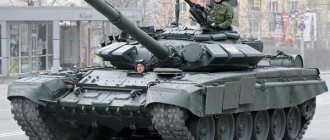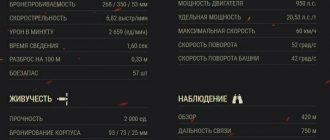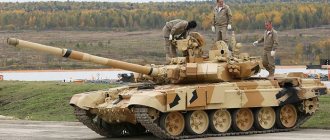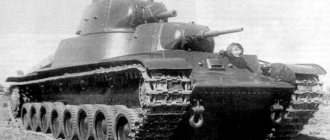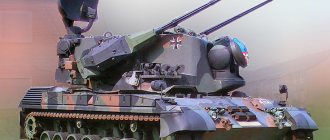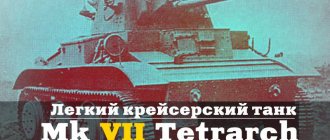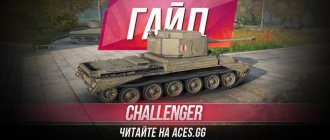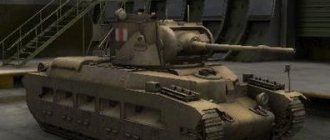Each country, to one degree or another, has certain military traditions that shape its historical path of development and influence its place in world geopolitics. So in Germany, Russia and France, the ground army with its guns and tanks always came first. Great Britain, like the United States, relied more on the navy and military aviation. The island nature of the state's territory was naturally reflected in the formation of military doctrine and influenced the development of certain types of weapons. Having become the birthplace of tanks, England lost its leading position in the world tank building by the middle of the 20th century. Only 50 years later, Britain was able to create a competitive vehicle - the Challenger 2 main battle tank. Before this, things in the English tank building industry were far from brilliant.
Characteristics of the Challenger 2 main battle tank
A country:Great BritainType:Main tankDate of issue:1988Length:11.57 mWidth:3.52 mHeight:2.49 mArmor, forehead:combined, equivalent to 800-1200 mm steel (presumably)Armor, side:combinedArmor, tower:combinedCrew:4 peopleEngine:Diesel Perkins CV 12TSA Condor, 1200 hp.Travel range:400 kmMaximum speed:56 km/hWeight:62.5 tonsWeapons:1x 120 mm L30A1 cannon (52 rounds), 1x 7.62 mm ATK Gun Systems Company L94A1 coaxial machine gun, 1x 7.62 mm L37A2 anti-aircraft machine gun (4000 7.62 mm rounds), 10x 66 mm launchers smoke grenades.
Description of design
Let's look at the key characteristics of the main battle land tank of the British Army.
Armament
The main turret weapon is a 120 mm rifled gun. Its ammunition capacity is 52 shells (high-explosive and armor-piercing), the firing range is up to 8 km. The vertical guidance angle can vary from -10 to +20°. The tank crews have 2 machine guns at their disposal: one is coaxial with a cannon, the second is intended for air defense and is controlled remotely, designed for 4,000 rounds. The cartridge caliber is 7.62 mm. The list of weapons also includes two thermal imagers and an optical sight.
Armor protection
The tank is equipped with a block multilayer combined armor system, the details of which are a state secret. In addition, the hull is protected by additional hinged armored screens and grilles. Inside there are devices that protect the crew from radioactive, chemical and biological hazards. On both sides of the tower there are 5 installations that fire smoke grenades. The tank also has a smoke screen mechanism. Vulnerable areas are considered to be the lower frontal part, where the armor is no more than 100 mm thick.
The history of the creation of the Challenger 2 tank
The Challenger 2 main tank is a modernization of the Challenger 1 tank completed by Vickers Defense Systems in 1988. It differs from its progenitor in the design of the turret, gun, weapon control system, as well as a significantly modified chassis.
Testing of the first Challenger 2 prototype began in 1989, and in 1994 its mass production began (Vickers plant in Leeds). By the time the first batch of 127 tanks was delivered, the vehicle was still too raw, so by 1997, less than a third of the order was completed. Only by this time was it possible to more or less resolve the problems with the fire control system and other minor design flaws and establish normal production of the tank.
In total, until 2002, 386 tanks were delivered to the troops, plus another 38 vehicles were delivered under a contract to Oman. In 2009, the Challenger 2 program was closed; the tanks themselves will remain in British service until 2035.
Design of the Challenger 2 tank
The layout of the Challenger 2 tank is classic, with a front control compartment, followed by a fighting compartment and a rear engine compartment.
The driver is located in the control compartment along the axis of the tank in a reclining position, with part of the ammunition located on both sides of his seat. The three remaining crew members are located in the turret: the gunner and commander to the right of the gun, the loader to the left. The hull and turret of the Challenger 2 tank are welded from second-generation Chobham multi-layer armor, the lower frontal hull plate is made of conventional armor, about 100 mm thick.
To increase the service life of the gun, the barrel bore is chrome-plated, the diameters of the trunnions and sockets for them are increased to reduce barrel vibrations in azimuth and elevation and, as a result, increase the accuracy of fire. The gun is stabilized in two planes, equipped with an ejector and a heat-insulating casing. The gun's ammunition includes 50 separate-loading rounds; shells and charges are stored separately from each other.
Drawing of the Challenger 2 tank
To the left of the gun is a coaxial 7.62 mm L94A1 Chain Gun machine gun. Near the commander's hatch on the turret there is a 7.62 mm L37A2 machine gun, which serves mainly for air defense. Two blocks of five 66-mm smoke grenade launchers each are mounted on the front plates of the turret. The tank's fire control system uses a ballistic computer from the Canadian company General Dynamics Canada (an upgraded copy of the 1A1 Abrams tank - allows, in addition, to exchange data between tanks in real time), a stabilized commander's day sight VS 580 with a 360° viewing angle from the French company SFIM ( similar to that installed on the French Leclerc tank), as well as a stabilized main gunner’s sight with a laser rangefinder and thermal imaging unit developed by the same company.
Compared to the Challenger 1 tank, 44 changes were made to the design of the engine-transmission unit: new air filters were installed, the generator and starter, the cooling system, the transmission lubrication system, etc. were improved. The hull contains two external fuel tanks not connected to the engine power supply system. The engine is left unchanged.
The chassis and suspension have been significantly upgraded compared to Challenger 1 (156 changes), including the addition of a hydraulic track tensioning mechanism.
The main design differences of the next Challenger
The main highlight in the design of the new machine is the turret. Even during the design process, the designers tried to take into account the experience of creating similar products from their direct competitors, using a ready-made production base inherited from the production of previous models. Unlike its predecessor, the new tank had a completely different turret shape. Its configuration significantly reduced the radar signature field; the internal volume made it possible to accommodate new communications and fire control equipment. The internal space of the turret allowed it to freely accommodate three crew members, a gunner, a loader and a tank commander. The entire crew of the tank consisted of 4 people. The car received practically new electronic equipment. The emphasis of the electronic filling was the new interface - a single NATO standard, used not only in armored vehicles. Such equipment makes each combat vehicle interconnected with other combat units participating in the military operation.
The body of the new car was inherited from its predecessor. The mass of the tank has also been approximately preserved - 62 tons. Almost 60% of the vehicle's weight was made up of combined-type anti-ballistic armor. Such a large mass required the installation of a powerful engine on the combat vehicle. The tank received a 1200 horsepower CV12 diesel engine with a turbine that pumps air. However, even such a powerful propulsion system did not allow the main battle tank of the British army to move at speeds exceeding 50 km/h.
Thanks to new sighting devices, the time from target acquisition to shot does not exceed 8 seconds. On average, a trained crew could hit up to a dozen targets within one minute. The turret was designed to mount a new 120 mm rifled gun, which had high penetrating power and better ballistic characteristics.
The gun had a chrome-plated bore, which significantly increased the service life of the gun.
The excellent ballistic properties of the L30 tank gun were successfully demonstrated during the Second Gulf War. British armored forces in the area of the Iraqi city of Basra were opposed by tank units of the Iraqi Republican Guard. The British "Challengers" could do without routine maintenance for a long time, participating in collisions with enemy armored vehicles, hitting other ground targets at long distances.
Structurally, the weapon had some differences. The trunnions had a larger diameter, so the barrel was not subject to strong vibrations during shooting. This contributed to improving the quality of shooting. The percentage of hits on targets has increased significantly. The gun's ammunition capacity was 50 rounds. It should be noted that the British vehicle does not have an automatic loader. Unlike Russian and Ukrainian vehicles, where the functions of a gunner have sunk into oblivion, the new English tank clearly reflected British conservatism. Reliability is paramount.
Modifications of the Challenger 2 tank
Challehger 2 Control - Command tank for the brigade commander.
Challehger 2 Command - Command tank for the squadron commander.
Challehger 2 export, for Oman . It features a cooling system designed for operation in hot climates, the 7.62 mm machine gun from the loader's hatch was replaced with a 12.7 mm M2NV machine gun, the tank received different tracks, air conditioning and a GPS system.
Challehger 2 (for the 2003 invasion of Iraq) 116 Challehger 2 tanks and 28 Challehger ARRV ARVs received new side screens and improved air filters. In addition, all tanks participating in the operation received identification systems: thermal panels and chevrons.
British main tank "Challenger 2"
Challehger 2E , export modification. Instead of the Condor engine, a German MTU 883 V-12 engine with a power of 1500 hp was installed, and instead of a TN54 transmission, a Renk HSWL 295TM automatic transmission was installed, the capacity of the fuel tanks was increased, and the range was also increased to 550 km. The commander and gunner received the latest generation French SAGEM sights and a modern combat information and control system. The coaxial machine gun was replaced by the German MG ZA1, and provision was made for installing a 12.7 mm machine gun on the loader's hatch. It was not exported, but is considered the main option for modernizing the British Challenger 2 tanks.
Driver Training Tank - DTT. Training tank for training driver mechanics on the Challenger 2 chassis. Similar in design to the earlier Challenger Training Tank, on the Challenger 1 chassis.
Engineer Tank System is a family of engineering vehicles based on the Challenger 2 tank, created to replace similar vehicles based on the earlier Chieftain tank. The family includes Trojan Titan bridgelayers . The UK ordered 33 of both. Both vehicles are well armored and have good mine protection. Interestingly, they are not conversions of the base tanks, but are re-designed on the same chassis. The Troyan engineer tank has a crew of three (all in the front compartment), and a remote-controlled 7.62 mm machine gun is located next to the commander's hatch. On the upper frontal plate of the hull there are two blocks of 5 smoke grenade launchers. In front of the machine, on the right, there is a hydraulic boom-manipulator, in the rear of the machine there is a platform for transporting fascines. There is also a track-laying bulldozer blade. You can control all the elements without leaving the car, watching the process using 9 television cameras. The combat weight of the Troyan engineer tank is 57.5 tons, the maximum speed is 56 km/h. The Titan bridge layer is designed for transporting and laying two bridges on an obstacle, with a length of 26 and 13.5 m. The bridge layer is made according to the “scissors” scheme and in this respect copies the machines based on the Chieftain. The combat weight of the Titan bridge layer is 71.6 tons, the crew is 3 people.
"Challenger 2" and the American "Abrams" from some angles are twin brothers. And the point here is clearly not a single computing system
Combat use of the Challenger 2 tank
The Challenger 2 first took part in combat operations in 2000 in Kosovo - this operation required the command to additionally strengthen the tank - dynamic protection canopies in the lower frontal plate and Chobham screens on the sides. However, given the nature of that conflict, there were no serious battles involving the Challengers.
In 2003 in Iraq (Operation Telic), 120 Challenger 2s took part in combat operations, but again they never “clashed” with Iraqi tanks, even if they were old, all the while performing fire support tasks for British troops. In total, during the war in Iraq, 1 Challenger 2 was lost, and even then from the mistaken open fire of the same British tank.
A short introduction
Attempts by British designers to go their own way led to the fact that British tanks were no longer considered a formidable fighting force on the battlefield. Despite the rather long model range, British vehicles created during the Second World War could hardly be considered real competitors of the German PzKpfw VI tanks, known as the Tiger tank, or the PzKpfw V - “Panther” tank. British tanks also lost to Allied vehicles, the American M4 Sherman tank and the legendary Soviet T-34. Today the British can be proud of their Challenger 2 tank, which is, if not the most powerful armored fighting vehicle, then certainly the most modern. Previously, the situation looked dire. The British "Cromwells", "Churchills", "Matildas" and "Valentines" could not boast of large series and timidly trailed behind their more modern and technically advanced armored brothers.
